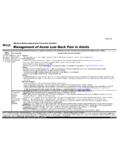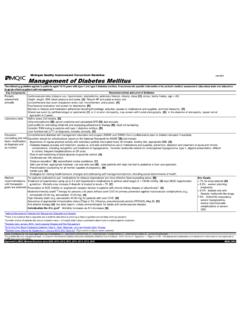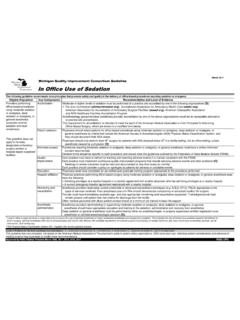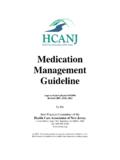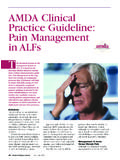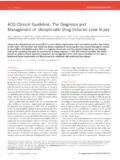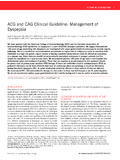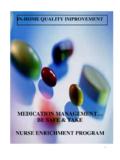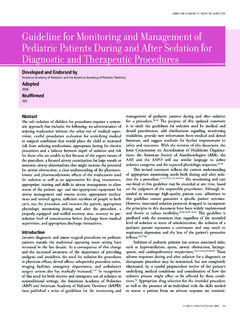Transcription of Michigan Quality Improvement Consortium Guideline Primary ...
1 January 2018. Michigan Quality Improvement Consortium Guideline Primary Care diagnosis and management of adults with depression The following Guideline recommends screening for depression , assessing suicide risk, following diagnostic criteria, shared decision-making and treatment planning, monitoring and adjusting treatment. Eligible Population Recommendation and Level of Evidence Frequency adults 18 years or Detection and diagnosis : Annually. More often if high risk. older, including Screen for depression , using a validated screening tool ( PHQ-2 or 9, Edinburgh Scale) with adequate systems in place to ensure accurate diagnosis , At the first prenatal care visit; on pregnant and effective treatment, and appropriate follow-up.
2 [B] postpartum visits (within 3-8. postpartum women Assess for comorbid conditions that might impact treatment ( , medical and medication-induced conditions, drug or alcohol abuse, bipolar disorder, weeks of discharge) and if anxiety disorders, psychosis). symptoms or signs raise Assess if criteria are met using DSM-5 criteria [A]. Criteria A, B, C and D must be met. suspicion using the DSM-5 criteria Major depression Persistent Depressive Disorder Edinburgh Postnatal depression Scale1. 3 total for 2 years. 5 total for 2 weeks and Must include symptom #1. must include symptom #1 or #2. A. Symptoms Never > 2 months symptom-free 1.
3 Depressed mood x x 2. Marked diminished interest/pleasure x 3. Significant weight gain/loss, appetite decrease/increase x x 4. Insomnia/hypersomnia x x 5. Psychomotor agitation/retardation noticeable by others x 6. Fatigue/loss of energy x x 7. Feelings of worthlessness or inappropriate guilt x x 8. Diminished concentration or indecisiveness x x 9. Recurrent thoughts of death or suicidal ideation x 10. Hopelessness x B. Symptoms cause clinically significant distress or impairment in functioning C. Symptoms not attributed to a substance or other medical condition D. Lack of psychotic disorder or history of manic or hypomanic symptoms Individuals diagnosed Assess risk of suicide by direct questioning about suicidal ideation, and if present, suicidal planning, potential means, and personal/family history of suicidal At each encounter addressing with a depressive attempts.
4 [D] See established clinical tools for risk assessment and suicide prevention2,3. depression until patient is treated to disorder n If patient at moderate to severe risk for suicide, refer to emergency department or crisis intervention center. Develop safety plan. remission. Treatment and follow-up: Schedule sufficient follow-up visits Educate and engage patient. Include self- management support and life-style modifications ( , behavioral activation, healthy sleep and diet, exercise, to assess response to treatment stress- management , social support, spiritual support, online resources) [C]. and titrate dose (typically every two Utilize shared decision-making in treatment planning [A].)
5 Consider onset and severity of symptoms, impairment, past episodes, psychosocial stressors, weeks, monthly at a minimum). [D]. medical and psychiatric comorbidities, patient preference, resource accessibility. For mild to moderate symptoms consider pharmacotherapy and/or evidence-based psychotherapy [A]. For severe symptoms consider both pharmacotherapy and evidence-based psychotherapy [A]. Monitor response to treatment using standardized scale ( , PHQ-9). On PHQ-9, adequate response is 50% reduction in score, remission=total score <5. Consider referral to behavioral health specialist when additional counseling is desired, Primary physician is not comfortable managing patient's depression , diagnostic uncertainty, complex symptoms or social situation, pregnancy, response to medication at therapeutic dose is not optimal, considering prescribing multiple agents, or more extensive interventions are warranted [D].
6 If initiating antidepressant medication, follow manufacturer's recommended doses. If no response after 2-4 weeks, increase dosage as tolerated not to exceed the highest recommended dose. If discontinuing antidepressant, be aware of need to taper some medications. If limited or no response to treatment, assess for non-adherence, inadequate dosing, diagnostic inaccuracy or comorbid conditions exacerbating symptoms. Consider: increased doses of medication or frequency of psychotherapy, switching treatments or augment treatment with other medications or psychotherapeutic interventions, consultation. Monitoring: If medication prescribed, continue monitoring for at least 9-12 months after acute symptoms resolve.
7 [A]. Patients with recurrent major depression and/or persistent depressive disorder ( 2 years) usually require lifelong treatment. 1. Edinburgh Postnatal depression Scale 2. Suicide Prevention for Primary Care Toolkit 3. Suicide Assessment Five-step Evaluation and Triage Levels of Evidence for the most significant recommendations: A = randomized controlled trials; B = controlled trials, no randomization; C = observational studies; D = opinion of expert panel This Guideline is based on several sources, including: Final Update Summary: depression in adults : Screening. Preventive Services Task Force, January 2016; American Psychiatric Association Diagnostic and Statistical Manual of Mental Disorders Fifth Edition - DSM-5; Nonpharmacological Versus Pharmacological Treatments for Adult Patients with Major Depressive Disorder, AHRQ Publication No.
8 15(16)-EHC031-EF, AHRQ, December 2015; Adult depression in Primary Care health care Guideline . Institute for Clinical Systems Improvement , updated September 2013; Suicide Prevention Toolkit for Primary Care; Suicide Assessment Five-Step Evaluation and Triage - SAFE-T. Individual patient considerations and advances in medical science may supersede or modify these recommendations. Approved by MQIC Medical Directors January 2002, 2004, 2006, 2008, 2010, 2012, 2014, 2016, 2018


